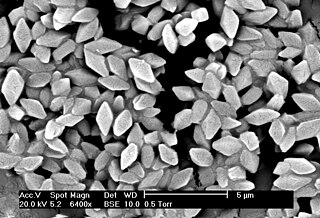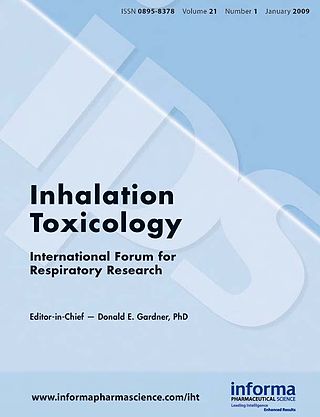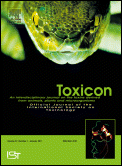
Bacillus thuringiensis is a gram-positive, soil-dwelling bacterium, the most commonly used biological pesticide worldwide. B. thuringiensis also occurs naturally in the gut of caterpillars of various types of moths and butterflies, as well on leaf surfaces, aquatic environments, animal feces, insect-rich environments, and flour mills and grain-storage facilities. It has also been observed to parasitize other moths such as Cadra calidella—in laboratory experiments working with C. calidella, many of the moths were diseased due to this parasite.

A toxin is a naturally occurring organic poison produced by metabolic activities of living cells or organisms. They occur especially as proteins, often conjugated. The term was first used by organic chemist Ludwig Brieger (1849–1919) and is derived from the word "toxic".

Toxicology is a scientific discipline, overlapping with biology, chemistry, pharmacology, and medicine, that involves the study of the adverse effects of chemical substances on living organisms and the practice of diagnosing and treating exposures to toxins and toxicants. The relationship between dose and its effects on the exposed organism is of high significance in toxicology. Factors that influence chemical toxicity include the dosage, duration of exposure, route of exposure, species, age, sex, and environment. Toxicologists are experts on poisons and poisoning. There is a movement for evidence-based toxicology as part of the larger movement towards evidence-based practices. Toxicology is currently contributing to the field of cancer research, since some toxins can be used as drugs for killing tumor cells. One prime example of this is ribosome-inactivating proteins, tested in the treatment of leukemia.

Neurotoxins are toxins that are destructive to nerve tissue. Neurotoxins are an extensive class of exogenous chemical neurological insults that can adversely affect function in both developing and mature nervous tissue. The term can also be used to classify endogenous compounds, which, when abnormally contacted, can prove neurologically toxic. Though neurotoxins are often neurologically destructive, their ability to specifically target neural components is important in the study of nervous systems. Common examples of neurotoxins include lead, ethanol, glutamate, nitric oxide, botulinum toxin, tetanus toxin, and tetrodotoxin. Some substances such as nitric oxide and glutamate are in fact essential for proper function of the body and only exert neurotoxic effects at excessive concentrations.

Saxitoxin (STX) is a potent neurotoxin and the best-known paralytic shellfish toxin (PST). Ingestion of saxitoxin by humans, usually by consumption of shellfish contaminated by toxic algal blooms, is responsible for the illness known as paralytic shellfish poisoning (PSP).

Ostraciidae or Ostraciontidae is a family of squared, bony fish belonging to the order Tetraodontiformes, closely related to the pufferfishes and filefishes. Fish in the family are known variously as boxfishes, cofferfishes, cowfishes and trunkfishes. It contains about 23 extant species in 6 extant genera.

The trichothecenes are a large family of chemically related mycotoxins. They are produced by various species of Fusarium, Myrothecium, Trichoderma/Podostroma, Trichothecium, Cephalosporium, Verticimonosporium, and Stachybotrys. Chemically, trichothecenes are a class of sesquiterpenes.
A toxicant is any toxic substance, whether man-made or naturally occurring. By contrast, a toxin is a poison produced naturally by an organism. The different types of toxicants can be found in the air, soil, water, or food.

Xenobiotica is a peer-reviewed medical journal that publishes comprehensive research papers on all areas of xenobiotics. It is published by Informa plc and covers six main areas:

Environmental toxicology is a multidisciplinary field of science concerned with the study of the harmful effects of various chemical, biological and physical agents on living organisms. Ecotoxicology is a subdiscipline of environmental toxicology concerned with studying the harmful effects of toxicants at the population and ecosystem levels.

Inhalation Toxicology is a monthly peer-reviewed medical journal that publishes review articles on the mechanisms, responses and assessments of toxins. It is published by Informa. The editor in chief is Donald E. Gardner. Inhalation Toxicology publishes 14 issues per year in simultaneous print and online editions.

The Journal of Immunotoxicology is a quarterly peer-reviewed scientific journal that publishes articles in the fields of immunotoxicology, immunology, and toxicology. It is published by Informa.

Toxicology Mechanisms and Methods is a peer-reviewed medical journal covering research on all aspects of toxicology. The editor-in-chief is Rakesh Dixit. The journal is published 9 times per year by Informa. According to the Journal Citation Reports, the journal has a 2015 impact factor of 1.476.
The MON 810 corn is a genetically modified maize used around the world. It is a Zea mays line known as YieldGard from the company Monsanto. This plant is a genetically modified organism (GMO) designed to combat crop loss due to insects. There is an inserted gene in the DNA of MON 810 which allows the plant to make a protein that harms insects that try to eat it. The inserted gene is from the Bacillus thuringiensis which produces the Bt protein that is poisonous to insects in the order Lepidoptera, including the European Corn Borer.
Mutation Research is a peer-reviewed scientific journal that publishes research papers in the area of mutation research which focus on fundamental mechanisms underlying the phenotypic and genotypic expression of genetic damage. There are currently three sections:

Toxicon is a peer-reviewed scientific journal of toxinology and the official journal of the International Society on Toxinology and the North American Society of Toxinology. It is published by Elsevier and the editor-in-chief is Ray Norton. It aims to publish original research, novel findings, and review papers on toxins and their chemical, toxicological, pharmacological, and immunological properties.

International Journal of Toxicology (IJT) is a peer-reviewed academic journal that publishes papers in the field of toxicology. The journal's editor is Mary Beth Genter, PhD. It has been in publication since 1982 and is currently published by SAGE Publications in association with American College of Toxicology.
Food and Chemical Toxicology is a peer-reviewed scientific journal covering aspects of food safety, chemical safety, and other aspects of consumer product safety. It is published by Elsevier and was established in 1963. The editor-in-chief is José L. Domingo.
Sibte Hasan Zaidi was an Indian pathologist and toxicologist. After his training in pathology at the Hammersmith Hospital in London, United Kingdom, he returned to India to continue experimental toxicology research initially at the Central Drug Research Institute, and then as Founding Director at Industrial Toxicology Research Center (ITRC) in Lucknow (1965-1978). During his later years, he served on national and international committees to increase awareness and set policy to prevent the harmful effects of industrial toxins in people.













